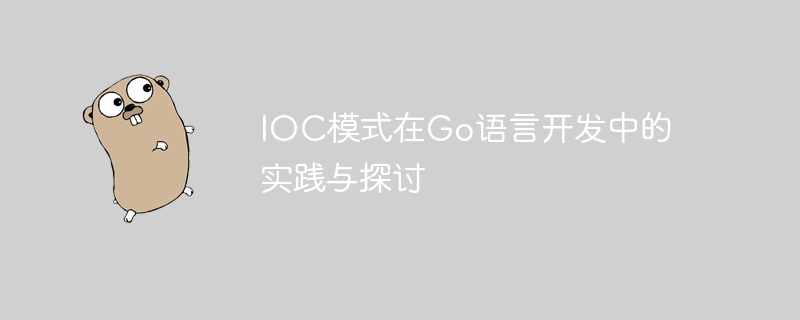Home >Backend Development >Golang >Practice and discussion of IOC mode in Go language development
Practice and discussion of IOC mode in Go language development
- PHPzOriginal
- 2024-03-22 12:51:031086browse

IOC (Inversion of Control) is a software design principle that transfers control of an application from the application itself to a framework or container. In this article, we will explore the practice of IOC pattern in Go language development and illustrate its application through specific code examples.
What is IOC mode?
The IOC pattern is a software design principle that aims to improve the reusability, flexibility, and testability of applications. In the traditional programming model, the application controls the creation and management of objects, while in the IOC model, control is transferred to an external container or framework. This means that the application itself is no longer responsible for managing object creation and dependencies, but instead hands these responsibilities to an external container or framework.
Practice the IOC pattern in the Go language
In the Go language, the IOC pattern can be implemented through interfaces and dependency injection. The interface defines the behavior of the object, and dependency injection is responsible for injecting the object's dependencies into the object.
Below we use a simple example to illustrate how to practice the IOC pattern in the Go language:
package main
import (
"fmt"
)
// 定义接口
type Greeter interface {
Greet()
}
// 定义实现接口的结构体
type EnglishGreeter struct{}
func (e EnglishGreeter) Greet() {
fmt.Println("Hello, IOC!")
}
// 定义依赖注入函数
func Greet(g Greeter) {
g.Greet()
}
func main() {
// 通过依赖注入的方式创建对象
eg := EnglishGreeter{}
Greet(eg)
}
In the above example, we first define a Greeter interface , and then defines an EnglishGreeter structure to implement the interface. Finally, in the Greet function, pass in the EnglishGreeter object through dependency injection and call its Greet method.
In this way, we separate the creation of objects and the management of dependencies from the application, achieving the effect of the IOC model. This approach not only improves the testability and maintainability of the code, but also makes the code more flexible and extensible.
Summary
The IOC pattern is an important design principle that improves the quality of software design and can make applications more flexible, scalable, and testable. In the Go language, the IOC pattern can be well practiced and applied through interfaces and dependency injection.
Through the above examples, we can see how to implement the IOC pattern in the Go language and manage the dependencies between objects through dependency injection. I hope this article can provide readers with some inspiration and help for the practice of IOC mode in Go language development.
The above is the detailed content of Practice and discussion of IOC mode in Go language development. For more information, please follow other related articles on the PHP Chinese website!
Related articles
See more- How to install and configure the go language environment in ubuntu
- How to find the absolute value in Go language
- How to intercept a string in go language
- Using go language to develop Baidu Translation API to realize mutual translation between Chinese and Moroccan
- Use Go language to develop and implement high-performance speech recognition applications

